

Brunner and Suddarth's Textbook of Medical-Surgical Nursing, 11th edition. Eliminate the air of mystery from chest tubes. * Don't aggressively manipulate the chest tube don't strip or milk it.Ĭoughlin AM, Parchinsky C. * Don't clamp a chest tube, except momentarily when replacing the CDU, assessing for an air leak, or assessing the patient's tolerance of chest tube removal, and during chest tube removal. * Don't let the drainage tubing kink, loop, or interfere with the patient's movement. * When the chest tube is removed, immediately apply a sterile occlusive petroleum gauze dressing over the site to prevent air from entering the pleural space. * Assess vital signs, breath sounds, SpO 2, and insertion site for subcutaneous emphysema as ordered. Assist with repositioning or ambulation as ordered.

* Encourage the patient to perform deep breathing, coughing, and incentive spirometry. Report drainage that's excessive, cloudy, or unexpectedly bloody. Mark the drainage level on the outside of the collection chamber (with date, time, and initials) every 8 hours or more frequently if indicated. * Assess the amount, color, and consistency of drainage in the drainage tubing and in the collection chamber. Notify the health care provider immediately if you can't identify an external leak or correct it. Look for constant or intermittent bubbling in the water-seal chamber, which indicates leaks in the drainage system. You should see fluctuation (tidaling) of the fluid level in the water-seal chamber if you don't, the system may not be patent or working properly, or the patient's lung may have reexpanded. Make sure the water-seal chamber is filled with sterile water to the level specified by the manufacturer. If using suction, make sure the suction unit's pressure level causes slow but steady bubbling in the suction control chamber. * Ensure that the suction control chamber is filled with sterile water to the 20-cm level or as prescribed. Make sure all connections are taped and the chest tube is secured to the chest wall. * Keep the system closed and below chest level. If your patient has a traditional water-seal chest drainage unit (CDU), you'll need to manage the system. Facing Ethical Challenges with Strength and CompassionĪ CHEST TUBE is inserted to remove air, blood, or excess fluid from the pleural space and reexpand the involved lung.
Pleur evac water seal professional#
Establishing Yourself as a Professional and Developing Leadership Skills.Ensuring Patient & Family Centered Care.Developing Critical Thinking Skills and Fostering Clinical Judgement.Lippincott NursingCenter’s Critical Care Insider.Lippincott NursingCenter’s Career Advisor.Nursing Resources on Caring for Patients who are LGBTQ+.Scale your Influence and Expertise through Clinical Education.The Pleur-Evac Chest Drainage System, the patented solution for thoracic, cardiovascular, trauma and critical. Improving Outcomes by Caring for Communities Water Sealed Drainage System in Bengaluru.COVID-19 2022 Update: The Nursing Workforce.The Nursing Workforce: An Interview with Dr.


 0 kommentar(er)
0 kommentar(er)
